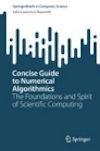- About MAA
- Membership
- MAA Publications
- Periodicals
- Blogs
- MAA Book Series
- MAA Press (an imprint of the AMS)
- MAA Notes
- MAA Reviews
- Mathematical Communication
- Information for Libraries
- Author Resources
- Advertise with MAA
- Meetings
- Competitions
- Programs
- Communities
- MAA Sections
- SIGMAA
- MAA Connect
- Students
- MAA Awards
- Awards Booklets
- Writing Awards
- Teaching Awards
- Service Awards
- Research Awards
- Lecture Awards
- Putnam Competition Individual and Team Winners
- D. E. Shaw Group AMC 8 Awards & Certificates
- Maryam Mirzakhani AMC 10 A Awards & Certificates
- Two Sigma AMC 10 B Awards & Certificates
- Jane Street AMC 12 A Awards & Certificates
- Akamai AMC 12 B Awards & Certificates
- High School Teachers
- News
You are here
Concise Guide to Numerical Algorithmics

Publisher:
Springer
Publication Date:
2023
Number of Pages:
84
Format:
Paperback
Price:
49.99
ISBN:
978-3-031-21761-6
Category:
Monograph
[Reviewed by , on ]
Bill Satzer
04/16/2023
This short book is an attempt by the author to provide a broader context for thinking about the relationship between numerical analysis and what we think of now as computer science. His aim appears to be developing a unified field that he calls numerical algorithmics, a discipline that would broadly support computational science and engineering.
When academic departments of computer science were new, numerical analysis was a primary component of their curriculum. But by the 1990s, numerical analysis was largely brought into mathematics departments. According to the author, this had the consequence of taking fundamental models of computation and complexity theory (developed in theoretical computer science) back into mathematics, where it had originated in the 1930s with mathematical logicians.
Several issues now separate numerical analysis from more standard computer science. One is the sense that numerical analysis deals with the continuous while computer science handles the discrete. Another is a history of numerical analysts focusing on approximations, and computer scientists focusing on algorithms. Probably another is simply an institutional bias that separates one academic specialty from another.
A “deleterious consequence” of the repatriation of numerical analysis to mathematics, according to the author, is that it meant building a practical, solid foundation for numerical computation – especially as it pertains to real numbers – was left unfinished. The development of the finite-precision, floating point model and round-off analysis had been accomplished. But the broader question of treating real numbers computationally was left undone. More recent work on universal number arithmetic has offered some alternatives. (As an example, the author offers the “unum” arithmetic framework, at least one version of which is compatible with interval arithmetic.)
The author describes the history of the overall subject of numerical and symbolic computation. He suggests that some of the best-known figures had expressed opinions that focused more on the general concept of algorithm, and saw fewer distinctions between the numerical and the more broadly symbolic.
This is a book that would be of most interest to those teaching numerical analysis. The history and perspective the author offers give a good sense of where their field sits with respect to conventional computer science and might suggest alternative ways to present the subject.
Bill Satzer (bsatzer@gmail.com), now retired from 3M Company, spent most of his career as a mathematician working in industry on a variety of applications. He did his PhD work in dynamical systems and celestial mechanics.
See the publisher's website.
- Log in to post comments




